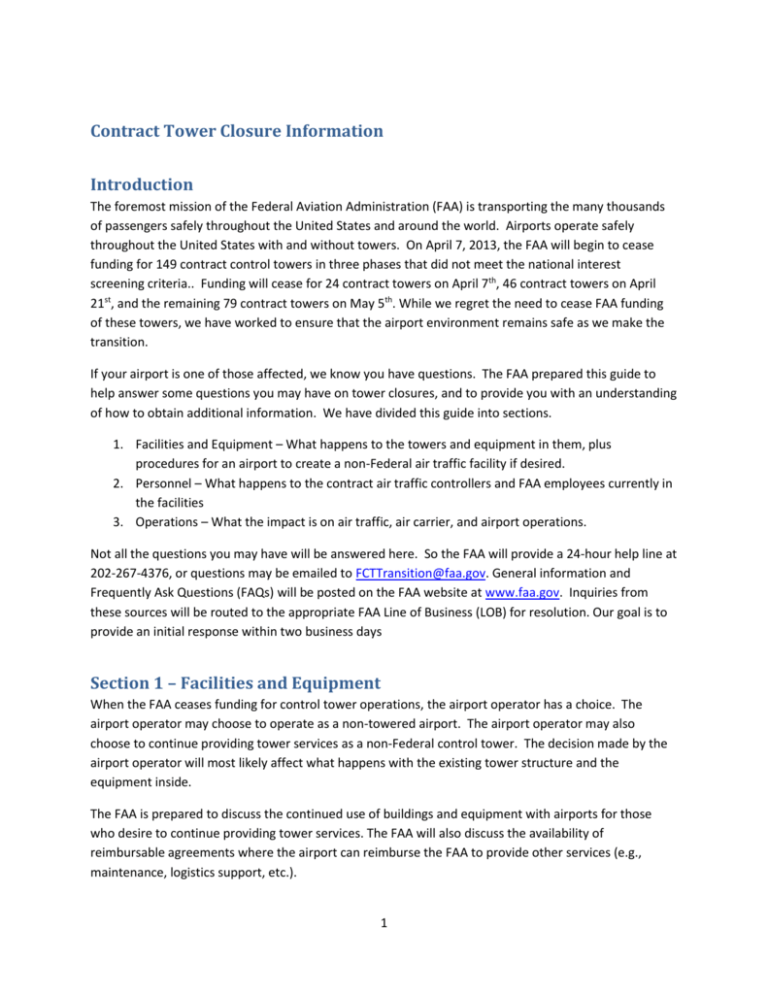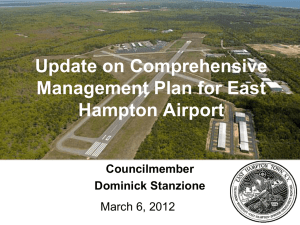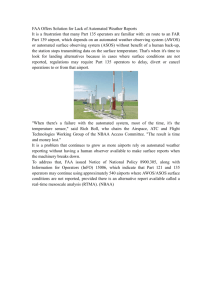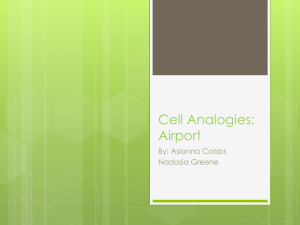What happens after a tower closure? Thousands of
advertisement

Contract Tower Closure Information Introduction The foremost mission of the Federal Aviation Administration (FAA) is transporting the many thousands of passengers safely throughout the United States and around the world. Airports operate safely throughout the United States with and without towers. On April 7, 2013, the FAA will begin to cease funding for 149 contract control towers in three phases that did not meet the national interest screening criteria.. Funding will cease for 24 contract towers on April 7th, 46 contract towers on April 21st, and the remaining 79 contract towers on May 5th. While we regret the need to cease FAA funding of these towers, we have worked to ensure that the airport environment remains safe as we make the transition. If your airport is one of those affected, we know you have questions. The FAA prepared this guide to help answer some questions you may have on tower closures, and to provide you with an understanding of how to obtain additional information. We have divided this guide into sections. 1. Facilities and Equipment – What happens to the towers and equipment in them, plus procedures for an airport to create a non-Federal air traffic facility if desired. 2. Personnel – What happens to the contract air traffic controllers and FAA employees currently in the facilities 3. Operations – What the impact is on air traffic, air carrier, and airport operations. Not all the questions you may have will be answered here. So the FAA will provide a 24-hour help line at 202-267-4376, or questions may be emailed to FCTTransition@faa.gov. General information and Frequently Ask Questions (FAQs) will be posted on the FAA website at www.faa.gov. Inquiries from these sources will be routed to the appropriate FAA Line of Business (LOB) for resolution. Our goal is to provide an initial response within two business days Section 1 – Facilities and Equipment When the FAA ceases funding for control tower operations, the airport operator has a choice. The airport operator may choose to operate as a non-towered airport. The airport operator may also choose to continue providing tower services as a non-Federal control tower. The decision made by the airport operator will most likely affect what happens with the existing tower structure and the equipment inside. The FAA is prepared to discuss the continued use of buildings and equipment with airports for those who desire to continue providing tower services. The FAA will also discuss the availability of reimbursable agreements where the airport can reimburse the FAA to provide other services (e.g., maintenance, logistics support, etc.). 1 Although the provision of air traffic services under the Federal Contract program will cease beginning on April 7, 2013, the FAA will not begin removing equipment and terminating local service agreements immediately. In most cases it will take up to 90 days after the contract tower funding ceases for the FAA to begin disconnecting and removing equipment at the affected towers. FAA owned and maintained equipment that remains with the tower after becoming a non-federal tower will continue to be owned and maintained by the FAA subject to future discussions and possible agreement with the Airport. Section 2 – Personnel The control towers have a variety of personnel working inside today. Contract controllers, FAA employees, and others all work together to provide air traffic services to the flying public. As the FAA terminates its contracts for air traffic advisory services, the affected companies will determine the status of their employees. If the FAA has its own employees housed at these locations, then the necessary agreements will be made with airports to continue housing them or they will be relocated. Section 3 – Operations What happens after a tower closure? Thousands of airports operate safely throughout the United States with and without control towers today. This section explains what an airport operator needs to do differently, as well as any potential effects on air carrier operations. Questions regarding the potential use of airport grant funding should be handled through existing FAA processes. Any towered airport has a variety of items to consider when their tower closes. Frequencies – Closure of the tower does not inhibit the availability of a common traffic frequency which is used by pilots to operate at non-towered airports. The FAA will work with airports to ensure a common traffic frequency is available, along with any other communications capabilities that may be necessary (e.g., ASOS, ATIS, ETC.) Pilot-Activated Lights – In many instances, airports already have pilot-controlled lighting available since the vast majority of contract control towers close overnight. In the event the capability is not present, then alternative procedures may be used (e.g., leave lights on). Airports can work with their Airport District Offices to explore federal funding possibilities, through the Airport Improvement Program (AIP), for pilot controlled lighting capabilities. Weather Observation – Airports have many different types of weather reporting capabilities available to them. Airports may choose to acquire Contract Weather Observers or use Automated weather reporting systems (ASOS, AWOS, etc.) if they are available. The availability of weather information is a critical requirement for air carrier operations to arrive/depart at the airport. The FAA will work with airports, through reimbursable agreements, to ensure the desired level of weather reporting capabilities is available. 2 a. If a federally owned automated weather observation system (ASOS, AWSS or AWOS-C) is located on the airport and the ATCT would like to augment the automated weather reports, a non-Federal Weather Observing Agreement must be executed in accordance with JO 7900.5C, Appendix B. Diversions – Non-towered airports may be a diversion location for aircraft unable to land at their primary destination. Air carriers and private operators alike must abide by requirements to operate at these locations. Many air carriers operate at non-towered airports today and use non-towered airports as diversion airports. Modifications to Standards – Some airports may have approved Modifications to Standards that use an operating control tower as mitigation. Airports with these conditions are being identified by the FAA on a case-by-case basis for the potential effects on the Modification to Standard Notifying Tenants – Airports should notify airport tenants of the tower closure and assess what, if any, effect closing the tower has on the tenants’ operations. Airports must ensure that airfield controls currently located in the tower continue to be accessible or are relocated to ensure continued operations. Coordination should occur with the FAA and the current tower personnel to ensure any changes are made by the announced closure date, or later if agreed to by all parties. Airports must identify to the FAA who will control the airport diagram. As these contract towers cease operations, they will transfer the appropriate monitoring and control responsibilities to the AOCC Maintenance Control Center. In addition, airports certificated under “Title 49 Code of Federal Regulations Part 139 – Certification of Airports” have several requirements they must continue to meet when a tower closes. Overall – Any activity at an airport that relies on a tower to execute in the airport’s Airport Certification Manual must be reviewed to see what, if anything needs to be changed. The airport operator must submit for approval any changes to the Airport Certification Manual to the local FAA Regional Airports Office for approval. Examples may include: o Airport Emergency Plans and how the tower notifies Aircraft Rescue and Fire Fighting (ARFF) personnel. o How the airport operator will control access to the movement area. o How the airport will issue NOTAM’s. Driver Training for the Movement Area – Any airport with a tower that decreases operating hours to less than 24 hours a day must include in its driver training plan procedures to move on the airport while the tower is closed. Part 139 airports with towers operating less than 24 hours a day already have these procedures in their training plans and Airport Certification Manuals. These procedures become the main area of driver training when the tower closes completely. Modified training plans and revised Airport Certification Manuals must be submitted to your local FAA Regional Airports Office for approval before the new procedures are implemented. Airport Emergency Plan – Most Airport Emergency Plans at airports with operating control towers include procedures that the tower is responsible for in emergencies. For example, a tower may notify the airport operator and the Aircraft Rescue and Fire Fighting (ARFF) personnel 3 when an emergency occurs. Any procedural changes must be reflected in the Airport Emergency Plan and submitted to your local FAA Regional or Airports District Office for approval. Segmented Circles – An airport must include a segmented circle, a landing strip indicator, and traffic pattern indicator around a wind cone if: o There is no tower operating during air carrier operations; AND o Any runway on the airport has a right-turn traffic pattern. If both of those conditions are true, then the airport must install these items around a wind cone for each runway with a right-turn traffic pattern. 1 FAA/ATO Terminal District managers will work with airports as needed to ensure any operating agreements are in place as required to continue airport operations. These managers will also work with airports to provide Certified Tower Operator certification in the event the airport wishes to provide non-federal tower services o Airports must ensure the appropriate NOTAMs are issued in advance of the actual closure date, Notices to Airmen must be issued if the Air Traffic Control Tower is to be closed or there will be any change in the current operating hours or airspace changes1. Airports should contact the appropriate Flight Service Station to issue the necessary NOTAMs. The FAA recommends that the Air Traffic Manager or Airport Manager issue a “Letter to Airmen” to inform airport users of any airspace or ATCT operating hour changes. The Airport Manager should contact the appropriate FAA Airports District Office to advise them of the ATCT operating changes. The Airport Manager should contact the local FAA Flight Standards District Office to notify them of any ATCT operating changes. The Airport Manager should contact the FAA Service Center Operations Support Group (OSG) Manager to ensure any necessary changes to Instrument Approach procedures are revised and/or updated. Contact information is provided in the FAQ’s available on the FAA website. Air Traffic Publications and Aeronautical Charts must be updated to reflect the changes. The FAA Service Area Point of Contact and Operations Support Group (OSG) should also provide assistance. Airports should contact their Airports District Office, or their Airport Certification Inspector to ensure the Airport Master Record, (FAA Form 5010) is current. Reference JO 7930.2, Chapter 5 (Section 5) & Chapter 6 4



